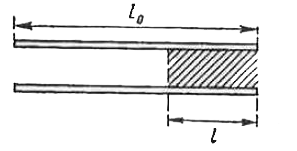Is there any kind of material which when placed between the plates of capacitor reduces its capacitance ?
To answer the question of whether there is any kind of material that, when placed between the plates of a capacitor, reduces its capacitance, we can follow these steps:
1. Understanding Capacitance:
- Capacitance (C) of a capacitor is defined as the ability of the capacitor to store charge per unit voltage. The formula for capacitance is given by:
C=εAd
where ε is the permittivity of the material between the plates, A is the area of the plates, and d is the distance between the plates.
2. Role of Dielectric Material:
- When a dielectric material is placed between the plates of a capacitor, it affects the capacitance. The capacitance with a dielectric is given by:
C′=εrε0Ad
where εr is the relative permittivity (dielectric constant) of the material and ε0 is the permittivity of free space.
3. Dielectric Constant:
- The dielectric constant of air is approximately 1. All other dielectric materials have a dielectric constant greater than 1. This means that when any dielectric material is inserted between the plates, the capacitance will increase.
4. Conclusion on Reducing Capacitance:
- Since the dielectric constant of air is the lowest (1), and all other materials have a dielectric constant greater than 1, there is no material that can be placed between the plates of a capacitor that will reduce its capacitance. Therefore, the answer to the question is no, there is no material that can reduce capacitance when placed between capacitor plates.
Final Answer:
No, there is no kind of material that can be placed between the plates of a capacitor to reduce its capacitance, as all materials have a dielectric constant greater than or equal to that of air (which is 1).
---
- Capacitance (C) of a capacitor is defined as the ability of the capacitor to store charge per unit voltage. The formula for capacitance is given by:
C=εAd
where ε is the permittivity of the material between the plates, A is the area of the plates, and d is the distance between the plates.
- When a dielectric material is placed between the plates of a capacitor, it affects the capacitance. The capacitance with a dielectric is given by:
C′=εrε0Ad
where εr is the relative permittivity (dielectric constant) of the material and ε0 is the permittivity of free space.
- The dielectric constant of air is approximately 1. All other dielectric materials have a dielectric constant greater than 1. This means that when any dielectric material is inserted between the plates, the capacitance will increase.
- Since the dielectric constant of air is the lowest (1), and all other materials have a dielectric constant greater than 1, there is no material that can be placed between the plates of a capacitor that will reduce its capacitance. Therefore, the answer to the question is no, there is no material that can reduce capacitance when placed between capacitor plates.
No, there is no kind of material that can be placed between the plates of a capacitor to reduce its capacitance, as all materials have a dielectric constant greater than or equal to that of air (which is 1).
Topper's Solved these Questions
- CAPACITORSBOOK - VMC MODULES ENGLISHCHAPTER - CAPACITORSEXERCISE - LEVEL 0 (Short Answer Type)
19 Videos
- CAPACITORSBOOK - VMC MODULES ENGLISHCHAPTER - CAPACITORSEXERCISE - LEVEL 0 (LONG ANSWER TYPE)
3 Videos
- BASIC MATHEMATICS & VECTORSBOOK - VMC MODULES ENGLISHCHAPTER - BASIC MATHEMATICS & VECTORSEXERCISE - Impeccable
50 Videos
- CURRENT ELECTRICITYBOOK - VMC MODULES ENGLISHCHAPTER - CURRENT ELECTRICITYEXERCISE - IN-CHAPTER EXERCISE-F
10 Videos
Similar Questions
Three difference dielectrics are filled in a paralled plate capactior as shown. What should be the dielectric constant of a material, which when fully filled between the plates produces same capacitance ?

View SolutionIf a thin metal foil of same area is placed between the two plates of a parallel plate capacitor of capacitance C, then new capacitance will be
View Solution
Knowledge Check
Assertion: The distance between the parallel plates of a capacitor is halved, then its capacitance is doubled.
Reason: The capacitance depends on the introduced dielectric.AIf both assertion and reason are ture and reason is the correct explanation of assertion.BIf both assertin and reason are ture but reason is not the correct explanation of assertion .CIf assertion is true but reason is false.DIf both assertion and reason are false.
A sheet of aluminium foil of negligible thickness is introduced between the plates of a capacitor. The capacitance of the capacitor
View SolutionAssertion : When a metallic plate is partially inserted between the plates of a capacitor its capacity increases.
Reason : If conductivity of conducting plate is more, then increase in capacity will be more.
View SolutionFind the capacitance of a capacitor in which the space between the plates is partly filled with a dielectric (Fig. 25.5)

View SolutionTwo parallel plate capacitors, each of capacitance 40 muF, are connected is series. The space between the plates of one capacitor is filled with a dielectric material of dielectric constant K =4. Find the equivalent capacitacne of the system.
View SolutionA dielectric slab is placed between the plates of a parallel plate capacitor. Its capacitance
A. become zero
B. remains the same
C. decrease
D. increase
View SolutionThe parallel combination of two air filled parallel plate capacitor of capacitance C and nC is connected to a battery of voltage, V. When the capacitors are fulley charged, the battery is removed and after that a dielectric material of dielectric constant K is placed between the two plates of the first capacitors. the new potential difference of the combined system is
View SolutionThe' distance between the plates of a parallel plate capacitor is d. A metal plate of thickness d/2 is placed between the plates. What will e its effect on the capacitance.
View Solution
